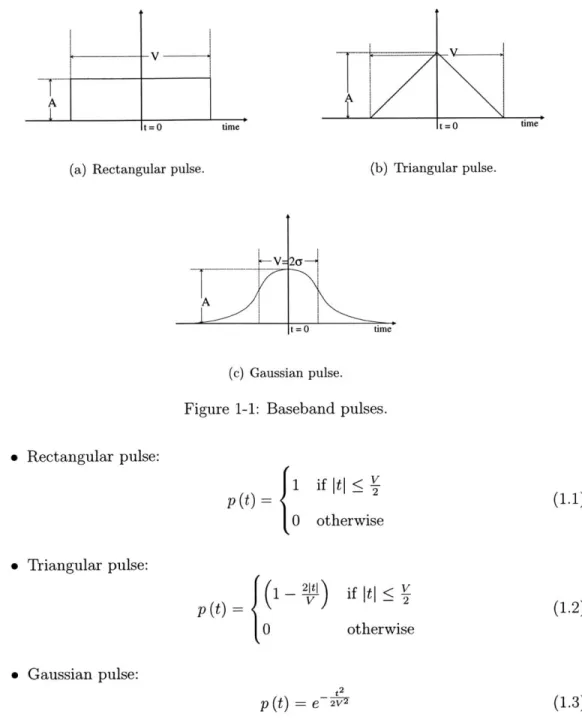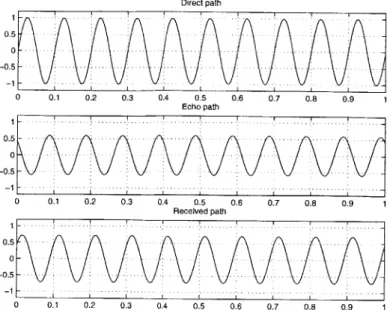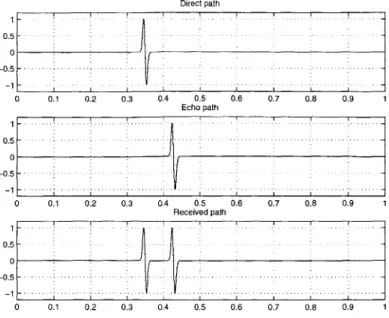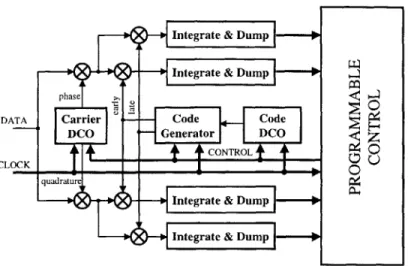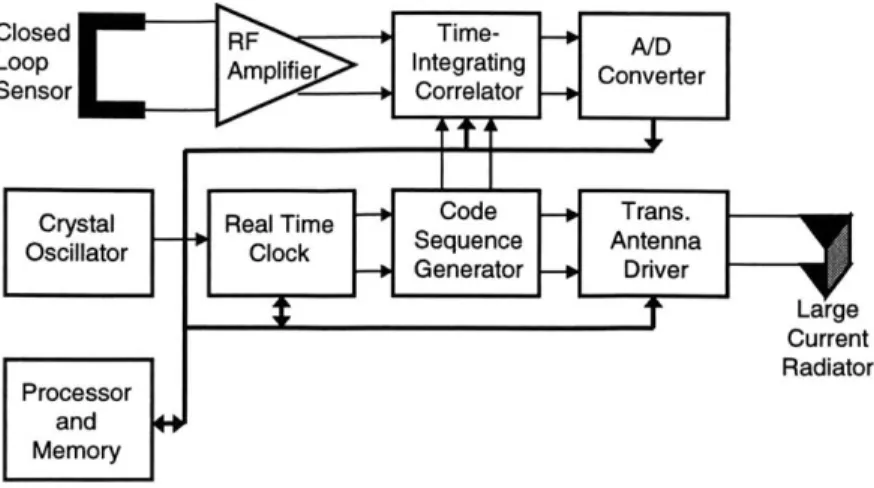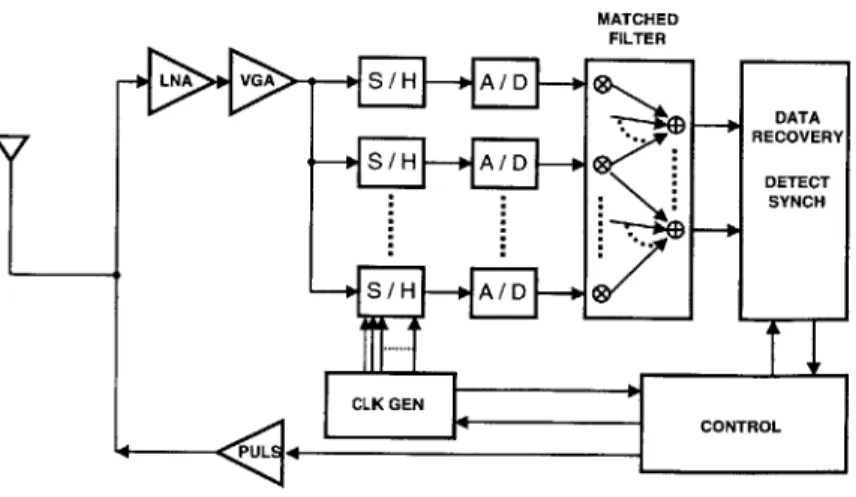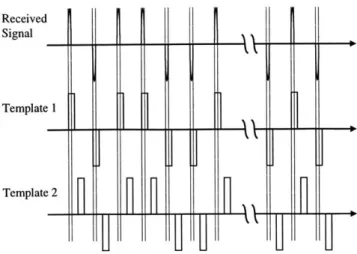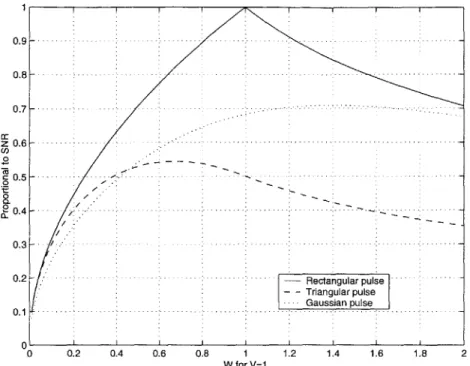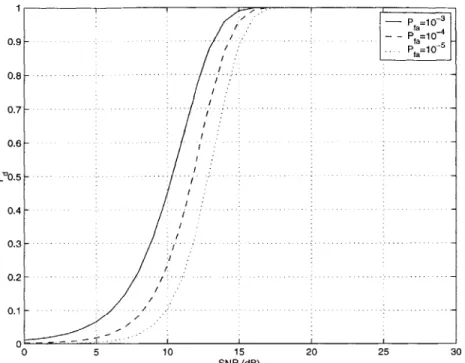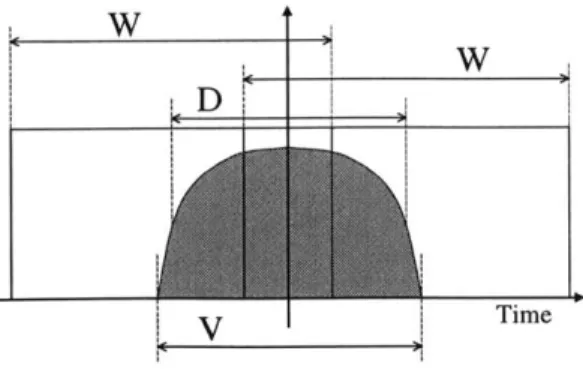Design of Synchronization Subsystem for an Ultra
Wideband Radio
by
Raul Blazquez-Fernandez
Submitted to the Department of Electrical Engineering and Computer
Science
in partial fulfillment of the requirements for the degree of
Master of Science in Electrical Engineering and Computer Science
at the
MASSACHUSETTS INSTITUTE OF TECHNOLOGY
May 2003
@Massachusetts
Institute of Technology. All rights reserved.
Author .... .... . -:
Department of Electrical Engineering and Computer Science
May 9, 2003
Certified by...
Anantha P. Chandrakasan
Associate Professor
Thesis Supervisor
Accepted by...
Artl ur C. Smith
Chairman, Department Committee on Graduate Students
MASSACHUSETTS INSTITUTE OF TECHNOLOGY
Design of Synchronization Subsystem for an Ultra Wideband
Radio
by
Raul Blazquez-Fernandez
Submitted to the Department of Electrical Engineering and Computer Science on May 9, 2003, in partial fulfillment of the
requirements for the degree of
Master of Science in Electrical Engineering and Computer Science
Abstract
Ultra Wideband (UWB) systems are receiving recently more attention due to its approval by FCC. The systems that have been already implemented are based in analog correlation. This thesis is part of an effort to implement a wholly digital Ultra Wideband receiver. Synchronization of a signal is a first step to perform the correct demodulation of the data contained in it. It is a problem whose complexity does not scale linearly with the bandwidth of the received signal. In UWB bandwidths are over 1 GHz, and the synchronization process has an important impact in the overhead needed in each data packet compared to the amount of information. In this thesis, the synchronization subsystem of an all digital UWB receiver is designed, taking into account the specific properties of UWB signals.
Thesis Supervisor: Anantha P. Chandrakasan Title: Associate Professor
Acknowledgments
I would like to thank Prof. Anantha Chandrakasan, for giving me the opportunity of working in this hectic and interesting area, and teaching me to look with different eyes to what I knew in signal processing, while providing the best foundation and guidance to explore the area of digital circuit design, completely new to me. His encouragement and patience have been essential for the completion of this thesis. I consider myself lucky for working with such a prominent leader in the field of circuits and systems.
I would like to thank Puneet Newaskar and Fred Lee of the UWB, wonderful
friends and colleagues, for their support and patience. Working with them has been an enriching experience, both professionally and personally. Their sense of humor, attitude, confidence, and the many conversations have made this time really interest-ing.
Many thanks to the Digital Integrated Circuits and Systems group, both present and graduated students Manish Bhardwaj, Alice Wang, Rex Min, Theodoros Kon-stantakopoulos, Johnna Powell, Alexandra Kern, Julia Cline, Dave Wentzloff, Ben Calhoun, Travis Simpkins, Frank Honore, SeongHwan Cho, Nathan Ickes. They make the group a great place to be. Their friendship and help are greatly appreci-ated. I also would like to thank Margaret Flaherty, our administrative assistant, for her skilled support.
I would also like to thank La Caixa Fellowship Program, for the opportunity they gave me to pursue my research interests abroad. Their efficient management of the different stages of the fellowship makes it one of the best possible ways of starting graduate studies in an American university. This research has also been sponsored
by Hewlett-Packard under the HP/MIT Alliance.
Finally, I would like to thank my parents, Magdalena and Felix, for so many things that would not fit neither in one, nor in a hundred pages. Thank you for everything.
Finalmente, me gustaria dar gracias a mis padres, Magdalena and Felix, por tantas cosas que no cabrian ni en una ni en cien paginas. Gracias por todo.
Contents
1 Introduction
1.1 UW B signal ...
1.1.1 Time representation . . . .
1.1.2 Frequency representation . . . . .
1.1.3 Advantages of UWB systems . . .
1.2 Previous work . . . .
1.2.1 A CDMA receiver . . . .
1.2.2 UWB receiver, analog correlation
1.2.3 UWB receiver, digital correlation
1.3 Objectives of the thesis . . . .
1.3.1 Assumptions . . . .
1.3.2 Tracking algorithm . . . .
1.3.3 Structure of the thesis . . . .
2 Coarse acquisition
2.1 Coarse acquisition algorithm . . . .
2.1.1 Matched filter : Adaptation to a simple integration window . .
2.1.2 Definition of Pd and Pf . . . ..
2.1.3 Specification of the value of D . . . .
2.2 Definition of the coarse acquisition process as a discrete stochastic process
2.2.1 Coarse acquisition as a Markov chain . . . .
2.2.2 Mathematical characterization of the model for coarse acquisition
2.2.3 Generalization of results when parallel architectures are possible
17 . . . . 18 . . . . 18 . . . . 2 3 . . . . 24 . . . . 27 . . . . 2 7 . . . . 30 . . . . 32 . . . . 33 . . . . 3 3 . . . . 34 . . . . 36 39 39 43 45 46 49 50 52 55
2.3 Effect of a difference in frequency between clocks . . . . 2.3.1 Conventions and models . . . .
2.3.2 Non-idealities of the estimator . . . .
2.4 Sum m ary . . . .
3 Fine Tracking
3.1 Necessity of a fine tracking algorithm . . . .
3.2 A nalysis . . . .
3.2.1 Model of the system after coarse synchror
3.2.2 Effect of a frequency offset . . . .
3.2.3 Effect of a delay difference . . . .
3.2.4 Effect of random noise . . . .
3.2.5 Choice of the coefficients of the filter . .
3.3 Definition of the delay estimator . . . .
3.3.1 Impact of AWGN . . . .
3.3.2 Impact of difference of frequencies . . . . 3.3.3 Impact of the granularity of the division
3.3.4 Granularity of the corrections . . . .
3.4 Specification of the total jitter of the system . .
3.5 Sim ulation . . . .
3.6 Sum m ary . . . .
4 Implementation
4.1 Characteristics of the signal . . . .
4.2 Modes of operation of the receiver . . . .
4.3 General block diagram . . . .
4.4 Digital Front-end . . . .
4.4.1 Buffers . . . .
4.4.2 Control for the Digital Front-end . . . .
4.5 Back-end subsystem . . . . 4.5.1 Correlation subsystem . . . . . . . . 6 7 ization . . . . 67 . . . . 7 0 . . . . 7 1 . . . . 7 2 . . . . 7 2 . . . . 7 3 . . . . 7 4 . . . . 7 6 . . . . 7 6 . . . . 7 9 . . . . 7 9 . . . . 8 1 . . . . 8 1 83 . . . . 8 3 . . . . 8 4 . . . . 8 5 . . . . 8 8 . . . . 8 8 . . . . 9 0 . . . . 9 2 . . . . 9 2 . . . . . 56 . . . . . 56 . . . . . 59 . . . . . 63 65 . . . . . 65
4.5.2 Fine tracking . . . . 95
4.5.3 Coarse acquisition subsystem . . . . 98
4.6 Implementation of the delay adjustment . . . . 103
4.6.1 Required functionality . . . . 103
4.6.2 State machine for implementing the change in delay . . . . 106
4.6.3 Implementation of the Swapper . . . . 108
4.7 Interface of the receiver . . . . 108
4.8 Sum m ary . . . . 110
5 Conclusions 113 5.1 Future work . . . . 114
List of Figures
Baseband pulses. . . . . 19
W avelet pulses . . . . 20
UWB encoding of 1 and 0 . . . . 22
Frequency spectrum associated to different pulse shapes. . . . . 24
Frequency spectrum associated to a gold code example. . . . . 25
Multipath in a narrowband signal. . . . . 27
Multipath in a UWB signal. . . . . 28
Correlator channel in a CDMA receiver. . . . . 29
Architecture of UWB receiver with analog correlation . . . . 30
Structure of a doublet. . . . . 31
Architecture of UWB receiver by Berkeley Wireless Research Center. 32 Coarse acquisition algorithm. . . . . 35
Fine tracking algorithm. . . . . 35 1-1 1-2 1-3 1-4 1-5 1-6 1-7 1-8 1-9 1-10 1-11 1-12 1-13 2-1 2-2 2-3 2-4 2-5 2-6 2-7 2-8 41 41 42 43 45 47 47 48 Matched filter concept . . . .
Correlation obtained by multiplication with a template . . . . Received signal and possible templates . . . . D etail of Figure 2-3 . . . . Relation of SNRs in function of the relation between W and V . .
Pfa with absolute value. . . . .
Pfa with the threshold as parameter. . . . .
2-9 Loss in Signal to Noise Ratio due to misalignment of the integration
w indow . . . . . 48
2-10 Situation of two consecutive windows for coarse acquisition considera-tion s. . . . . 49
2-11 Pd in one of the two integration windows where part of the pulse is present as a function of D. . . . . 50
2-12 Coarse acquisition as a Markov process. . . . . 51
2-13 Notation on the pulse position estimation . . . . 57
2-14 Maximum frequency deviation for starting to have SNR loss as a func-tion of posifunc-tion r. . . . . 61
2-15 Change of probability of detection due to a difference in frequencies between transmitter and receiver . . . . 64
3-1 Fine tracking block diagram . . . . 67
3-2 Timing references for the Delay Locked Loop . . . . 68
3-3 Fine tracking block diagram, interpretation . . . . 69
3-4 Spectrum of error noise depending on the value of b . . . . 73
3-5 Estimation of the delay with a frequency difference between transmitter and receiver . . . . 77
3-6 Detail of Figure 3-5 . . . . 77
3-7 Mean square error due to quantization as a function of the number of b its . . . . 79
3-8 Error at the output of the finetracking loop . . . . 82
4-1 Block diagram of the receiver . . . . 86
4-2 Digital Front-end of the receiver . . . . 89
4-3 Signals generated by the control of the Digital Front-end . . . . 90
4-4 Signals generated by the control of the Digital Front-end . . . . 91
4-5 Block diagram of the correlation subsystem . . . . 92
4-6 Block diagram of Datapath 1 . . . . 93
4-8 Architecture for the fine tracking subsystem . . . . 97
4-9 Position of the Enable of the fine tracking subsystem with respect to other signals. . . . . 98
4-10 Architecture of the coarse acquisition subsystem . . . . 99
4-11 Architecture for the maximum and threshold block . . . . 100
4-12 Architecture for the preprocess block . . . 101
4-13 Architecture for the finetrack minus filter block included in the coarse acquisition subsystem . . . 102
4-14 Coarse acquisition subsystem control when no lock is achieved . . . . 103
4-15 Coarse acquisition subsystem control when lock is achieved . . . . 104
List of Tables
2.1 Optimum window ratio V/W... 46
2.2 M odel results . . . . 55
4.1 Change of state depending on the modification of the delay. . . . . . 107
4.2 Control of CI, C2 and C3 in the reordering circuit, Figure 4-16. . . . 108
Chapter 1
Introduction
Ultra Wide-band (UWB) has appeared recently as a new way of reusing spectrum
already allocated. The FCC has approved its use for communications [3], under
certain constraints, creating a great expectation around the emergence of transceivers using UWB.
In this chapter, the characteristics of a UWB are described, including how it can be defined, how the information is encoded and how different users can be distinguished. Its time structure is introduced along with its different parameters and their impact in the signal properties. This model allows to explain the advantages of the system. Next section focuses on the UWB receiver architecture. The trade-offs related to the optimum place in the receiver chain to perform the analog to digital conversion
(ADC) are indicated. Previous work, as a CDMA receiver (with many similarities to
the UWB receiver) and examples of UWB receivers with the ADC placed in different positions, is presented. Finally, the architecture chosen for this thesis is shown.
This architecture is closely related to how the demodulation and synchronization is performed. In the last section of this chapter a brief exposition of the synchronization algorithm appears, relating it to the architecture and specifying what parts of the block diagram of the system are the objective of this thesis.
1.1
UWB signal
The definition of an Ultra Wide-band signal in the literature is somewhat vague. Some possibilities are:
" A signal with a bandwidth greater than 500 MHz.
" A signal whose bandwidth is more than 25 % its center frequency.
These definitions allow for, for example, a CDMA signal with a chip' rate of 1 chip/ns or an OFDM signal whose total bandwidth is over that used in standard IEEE 802.11. But in this thesis, it will be understood as UWB signal one composed of very narrow
pulses (in the order of 1
ns
or even shorter) with small duty cycle (at most 1 % or 2%)[19].
1.1.1
Time representation
A UWB signal represents each bit of information with a stream of very narrow pulses,
each separated by a time interval much larger than its width. The number of pulses that are used for each bit depends on the length of a pseudorandom code that has three uses. The pseudorandom code whitens the spectrum of the signal, reducing its interference to narrowband systems. It also can be used to identify and separate the signals generated by two different and simultaneous transmitters. In order to detect the value of the bit sent, the pulses that comprise the same bit are integrated together, providing processing gain in adverse signal to noise ratio situations [17].
Each pulse of the signal is a delayed and scaled replica of an original template. The shape of this pulse determines the spectrum of the signal. The only characteristic of the pulse relevant to the architecture of the system is that there are not sign changes within one pulse. Examples of possible pulses can be seen in Figures 1-1(a),
1-1(b) and 1-1(c). For the purposes of both modeling and simulations, these are the
mathematical expressions that will be used:
V
t=O time t=O time
(a) Rectangular pulse. (b) Triangular pulse.
V=2a
t=0 time
(c) Gaussian pulse.
Figure 1-1: Baseband pulses.
" Rectangular pulse: p(t) 1 if It|$ < V 0 otherwise " Triangular pulse: PM (t = (1.2) 0 otherwise * Gaussian pulse: t2 P (t := e-2V2
(1.3)
These pulses are not intended to be perfect replicas of the pulses received but simple models that allow to examine the effect of the change of shape of the pulse in the algorithms. The aggregate effect of antennas and propagation channel in the shape of the pulse is out of the scope of this thesis. When the FCC approved the use of UWB signals for data communications, they also constrained the bandwidth
0.8 0.8 0.4 0.4 0.2 0.2 0 0 -0.2 -0.2 -0.4 -0.4 -0.6 . -0.6 -0.8 -0.8 - -08 -0.6 -0.4 -0.2 0 0.2 0.4 0.6 08 1 -1 -0.8 -06 -04 -0.2 0 0.2 0.4 06 0.8 1
(a) Sinusoid in a rectangular window. (b) Sinusoid in a gaussian window.
Figure 1-2: Wavelet pulses
of the signal that was to be used[3]. The kind of pulses allowed do not have low frequency components and resemble those shown in Figures 1-2(a) and 1-2(b). These signals are general wavelets obtained by multiplying a pulse by a carrier. They will not be taken into account for the design of this receiver, but the architecture will be flexible enough to accommodate for these kinds of pulses. Even in the case that a wavelet is used, the signal is treated as carrierless. An usual wireless transmission signal occupies a narrow bandwidth around a central carrier frequency. The concept of phase appears as a derivation of the concept delay, by assuming the steady state of the signal when taking a decision on the symbol. Information can be encoded in the amplitude of the signal (amplitude modulation schemes) or into the phase (frequency and phase modulations). In a UWB signal, steady state cannot be assumed. Fourier frequency analysis is no longer valid and a broader approach, like Laplace transform or time analysis, is needed. The phase concept disappears and it can no longer be used to encode information. In its place, the different delays between two consecutive pulses can be used to encode the identity of the transmitter, while an additional delay, common to all the pulses that compose a symbol, will encode the information.
In order to describe the UWB signal, let the bitstream of information be denoted
by a sequence of binary symbols bj (with values +1 or -1) for j = -oC, ..., oo. Let N,
be the number of pulses used to represent one bit, being the length of a pseudonoise
(PN) code ci (with i = 0, ..., N, - 1). Two examples of possible but not unique encoding schemes are shown below:
" Antipodal signaling [11] the mathematical expression of this kind of modula-tion is:
cc N,-1
SAP (t) A 1
3
bjcip (t - jNeTf - iTf) (1.4)j=-o i=O
where Tf is the time between two consecutive pulses. It is an integer multiple of the width of the pulses V. Both the PN code and the information bits modulate the sign of the pulses.
* PPM (Pulse Position Modulation) [10] : In this case, the PN sequence modulates the pulse positions (incrementing or decrementing them by multiples of Tc). The
data bits modulate the pulse stream by appending an additional time-shift Tb,
whose value will depend on bj. The expression for this kind of modulation is:
00 N,-1
SPPM (t) = A E E p (t -JNeTf -iT - iT- Tb) (1.5)
j=-oo i=O
Examples of these two kinds of modulations, including the differences between sending a "1" or a "0" are shown in Figures 1-3(a) and 1-3(b). In them, the pulse template is a rectangular pulse, but the same approach can be extended to any kind of pulses. Antipodal signaling is chosen for this thesis.
The PN codes used here for spreading the bit and distinguishing between different users may be the same as those used for a CDMA system. The properties that we are looking for are:
" The autocorrelation function must have a very narrow main lobe and its side lobes must be as small as possible.
" The cross-correlation between two codes of the same family must be as small as possible.
For this purposes we can choose a Gold code. These codes are generated using a shift
register of length m. The length of the code is n = 2' - 1. Its properties are found
'T.,
"0"
(a) Antipodal signaling.
T Tr Tr p. s
T T T0T TN, f T T T,
(b) PPM.
1.1.2
Frequency representation
The basic element of the UWB signal is the individual pulse p(t). Let P(jw) be its Fourier transform. To transmit one bit, N, pulses must be generated. In the case of antipodal signaling, the pulses are separated by a time interval Tc. This stream of pulses is obtained convolving the individual pulse with a train of impulses:
Nc-1
c (t) = c (t - iT) (1.6)
i=O The Fourier transform of this pulse train is;
Nc-1
C (.w) =
7cie'iTf
(1.7)i=O
The Fourier transform of one bit is, therefore, G (Jw) = P (jw) C (Jw).
The bit stream can be assumed to be a discrete stochastic process with certain characteristics. The transmitted signal is also an stochastic process that has a power spectrum density [17]
S (jOW) |G (jw)|2 Sb (jw) (1.8)
NeTf
With Sb being related to the autocorrelation of the bits. It is usual that if no coding
is included, they are uncorrelated and then Sb is constant for all frequencies. Let its value be equal to 1. Then, (1.8) becomes:
S
(jOW)
= P(jOW)
C(jOW)1
(1.9)The spectrum of the UWB signal is obtained from the spectrums of the pulse shape and the gold code. Figure 1-4 shows the spectrum for the three baseband pulses indicated in the previous section. Its equations are:
* Rectangular pulse:
1 . -- Rectangular 0.9- an 0.8 -\ 0.7 - -\ 0.6 - 0.5-0.4 0.3-0.2 01 00 1 1.5 2 2.5 normalized frequency
Figure 1-4: Frequency spectrum associated to different pulse shapes.
* Triangular pulse:
P(jw) 4 4 )(1.11)
" Gaussian pulse:
P (iW) =2 .Ve- (1.12)
C (jw) is, from equation (1.7) a periodic function in w. Its period is 27/Tf. Figure 1-5 shows an example of the spectrum of a Gold code. It is a highly irregular signal
and, when seen from a time interval much longer than its period, it looks white. In the case of using a wavelet, this spectrum is relocated to have a center frequency used to modulate the pulse. As an example, the spectrum of the signal depicted in Figure 1-2(a) (M = 6 complete cycles of the sinusoid are included in a rectangular pulse) would be a sinc squared of width 2/V centered at frequency M/V.
1.1.3
Advantages of UWB systems
Although pulsed communications is possibly one of the oldest ways of transmitting information using electromagnetic waves, it has not been considered as a means for communications until recently. Several of its characteristics should be highlighted now, although some of them are common to other already popular wideband systems
1 0 -- ---- --. -. -.-. -- -.-. . . . . . . ..-- 10 6- -4 --o o.i 0.2 0.3 0.4 0.5 0.'6 0.7 0.8 0.9 1 Frequency normalized to 1/T .
Figure 1-5: Frequency spectrum associated to a gold code example.
(like CDMA or OFDM):
Potentiality for a large data bit rate. Shannon's limit [18] shows that the max-imum capacity achievable in a channel with Additive White Gaussian Noise
(AWGN) with a signal to noise ration SNR and a bandwidth W is:
C =Wlog2 (1 + SNR) (1.13)
SNR is in natural units and W is in Hz. Capacity increases logarithmically with the power (or, what is the same, with the signal to noise ratio) and linearly with the bandwidth. Still, this does not mean that a UWB radio is going to be working close to the capacity of the channel because some signals are already using parts of that bandwidth. But, since a UWB signal uses a large bandwidth, less power is needed for transmitting the same bit rate with the same probability of error.
* Low probability of interception. This characteristic is shared with CDMA and OFDM systems. The structure of the UWB signal is very complex both in terms of bandwidth (the pulses are very narrow and the duty cycle is small) and additional PN codes (to provide medium access capabilities). A easy rule
of thumb is that both the complexity and/or time necessary to eavesdrop a signal grows with the square power of both the bandwidth and the code length, making a UWB signal the most difficult signal to lock to if its structure is not known.
* Multipath is an asset. In classical narrowband communication, fading appears as a steady state concept related to the presence of multipath. Multipath hap-pens when one or more echoes of a signal arrive to the transmitter with different delays. If several of these signals collide during the duration of a symbol, it
suf-fers fading, as, at the decision time for the symbol, these components compose
either constructively or destructively and cannot be separated. In Figure 1-6, a picture is shown with two echoes of a sinusoid and how they compose. In UWB pulses are narrow enough so that two consecutive echoes do not collide and can be identified and added with the proper signs [21], [4]. If the pulses are
1 ns long, in order to collide, two consecutive echoes must have paths whose
difference in distance is below 30 cm. If the pulses are only 0.2 ns wide, then the paths should only be 6 cm apart. The probability of this happening in an indoor environment are much smaller than for the case of a narrowband signal. Figure 1-7 shows this for the case in which the pulses are monocycles. It is im-portant to note that multipaths are easy to detect and distinguish and a RAKE receiver can be easily implemented to take advantage of it.
* Complexity of the receiver. This claim relies on the fact that UWB are conceived as baseband systems. An ADC can be placed right after the Low Noise Amplifier
(LNA) and the rest of the system can be implemented digitally. No frequency
or phase locked loops are necessary. After the FCC ruling this is no longer completely true as the kind of signal that is allowed to be used has a spectrum beginning at 3.1 GHz [3]. It is possible that the simplest way to perform the demodulation of this kind of signal is to include a multiplier of frequency, either in the analog or digital domain.
Direct path 0.5 0 -- -- --. . -... ... ... ....-- -0.5 -- -. - --- 1 - - - -0 0.1 0.2 0.3 0.4 0.5 06 07 0.8 0.9 Echo path 0 0.1 0.2 0 3 0.4 05eie pt 0.6 0.7 0.8 0.9 1 -1 -0 0.1 0.2 0.3 0.4 0.5 0.6 0.7 0.8 0.9 1
Figure 1-6: Multipath in a narrowband signal.
1.2
Previous work
This section shows the architecture of three receivers. First, as a paradigm of a broadband system, a CDMA receiver is presented. It has many points in common with the UWB system, and part of the intuition obtained here can be applied. Then, two proposed architectures for UWB systems are explained. The first one uses analog correlation. The second one uses a high speed ADC directly at the output of the LNA, and performs all the signal processing in digital domain. These two architectures constitute two opposite paradigms of the design of UWB receivers, and serve as examples to discuss the trade-offs involved in where to draw the line between the analog and digital domains [20].
1.2.1
A CDMA receiver
A CDMA receiver has several features:
o The receiver has a clear RF front-end that includes filters, amplifiers and fre-quency converters [7]. The signal is sampled at an intermediate frefre-quency. The
Direct path 0.5 -0 -0 .5 --. -.- -..--. -.- -. -. -.- -..--. .. .-.- -. .- .- -.- .- -.- ..- . -1 -0 0.1 0.2 0.3 0.4 0.5 0.6 0.7 0.8 0.9 1 Echo path 0 .5 - - - -. -. -. - -. - - - . . .-- - - ...-- ...-- 0 -- 0 .5 - - - - - - --- - - - -- -- - - - - -0 0.1 0.2 0.3 0.4 0.5 0.6 0.7 0.8 0.9 1 Received path 0 .5 -. .- - . - -- - - - - -0 -0 .5 - - - -. -. - - . .. -.-. -. . . . .-. . . . . .. . . .-. .-- -..-- -.- -- -0 0.1 0.2 0.3 0.4 0.5 06 07 08 0.9 1
Figure 1-7: Multipath in a UWB signal.
last frequency conversion is done in the digital domain. The oscillators used in the analog part are generated from the same common clock, but this signal is running freely without any control from the digital part. The only signal from the digital domain that feeds back to the analog part is the Automatic Gain
Control (AGC).
" Timing synchronization and symbol detection are completely performed in the
digital domain.
" The ADC used for sampling needs a small number of bits due to the processing
gain of the system that, for certain CDMA receivers can be over 40 dB.
A detail of the correlating channels of the receiver is shown in Figure 1-8 [8]. In order
to recover the information bits from the CDMA signal that comes in intermediate fre-quency, it is necessary to perform the last frequency down-conversion by multiplying the incoming signal with the carrier and to correlate with the pseudorandom code. Both are locally generated signals that need to be properly synchronized. Two tasks must be performed [2]:
Integrate & Dump 1
Integrate & Dump
DATA Carrier Code Code
DCO Generator DCO
CLOCK s= .- U
Integrate & Dump Integrate & Dump
Figure 1-8: Correlator channel in a CDMA receiver.
* Carrier synchronization: Due to the Doppler effect, the initial frequency can be fairly far from the center frequency of the local oscillator. A Phase Locked Loop (PLL) is very slow when the initial difference in frequencies is too large.
A Frequency Locked Loop(FLL), though fast enough to lock onto signals with
a variety of center frequencies, is too noisy to perform a proper tracking of the signal after having achieved lock. However, the solution is easy in the digital domain if part of the loop is programmable. From the block diagram in Figure
1-8 only the correlators (integrate and dump blocks, plus multipliers before
them) and the code and carrier generators are hardwired. The filter loop and, generally, all decisions related to the data coming from the integrate and dump blocks are controlled at low frequency through software. That way, different situations are detected, and either a FLL with large pull-in range or a PLL loop with good noise response can be used.
* Code synchronization: Also affected by the Doppler effect, but, as it is a lower frequency signal, the effect is smaller. More important in this case to align the chips of the incoming signal with those of the code generated. Due to the autocorrelation properties of the pseudonoise code, misalignment larger than half a chip results in loosing the signal. A Delay Locked Loop (DLL) provides
Closed RF Time-
A/D
Loop Amplifie Integrating Converter
Sensor Correlator
Crystal Real Time Code Trans.
Oscillator Clock Sequence Antenna
Generator --o Driver
Large Current Radiator Processor and +00 Memory
Figure 1-9: Architecture of UWB receiver with analog correlation
very good noise bandwidth but is ineffective at the beginning of the search, because the procedure is only linear within half a chip of perfect alignment. In order to bring the local generator within half a chip of the code in the incoming signal, a coarse synchronization algorithm (non-linear) must be used. As in the carrier synchronization, the loop is closed by software and is programmable.
The two most important characteristics of this receiver are: almost no feedback
be-tween the digital and the analog part is needed (only the Automatic Gain Control
-AGC) and the synchronization process has a part that is hardwired (and perform the
correlations) and a part that is programmable and can be changed to adapt it to the current situation of the receiver.
1.2.2
UWB receiver, analog correlation
The block diagram of an UWB receiver that uses analog correlation [1] is shown in Figure 1-9. As important points that should be highlighted of this receiver are:
9 The signal used is a doublet, as shown in Figure 1-10. This signal has two
pa-rameters, the width of each pulse (V) and the separation between the two pulses of the doublet (D). The doublet adds to the spectrum nulls at frequencies k/D
D
Figure 1-10: Structure of a doublet.
for any k integer. Changing D, the position of the nulls can be tuned to avoid certain bands (like those used by cell phones or wireless LAN applications).
" Detection and synchronization to the incoming signal implies analog correlation.
Due to its difficulties, a integrating window of width W, broader than the pulses is used. The result is that the SNR at the output of the correlators is smaller than the maximum achievable since not all of the processing gain is used. The losses to this procedure are equal to
w
10log (1.14)
V
Due to the structure of the receiver, there is no way of getting around these losses.
" The time integrating correlator feeds a pattern recognition processor in order
to perform the estimation of the delay of the signal. The system is precise to the limit imposed by the losses of the previous note, but too complex to the optimum receiver that is needed. In the system designed in this thesis no pattern recognition receiver is necessary.
* The time to achieve lock is given as several hundred of milliseconds. Most of this time is related to the complexity of the synchronization process that incorporates pattern recognition techniques for precision estimation of the delay, and the fact that small parallelization is used. For a locating application, this
MATCHED DATA RECOVERY SYNCH S/H A/D ACLK GENTI CONTROL
Figure 1-11: Architecture of UWB receiver by Berkeley Wireless Research Center.
may not be a problem. But for a communication application, it will force the system to use very long packets, that can impact in the complexity of other subsystems in the receiver. In order to make feasible its use, it is necessary to downsize this time interval by several orders of magnitude.
e
The ADC is placed after the time-integrating correlator. It can have areason-able number of bits without having to spend too much power. On the other hand, the programmability and the possibility of changing parameters of the receiver are limited by the same fact.
1.2.3
UWB receiver, digital correlation
A digital receiver architecture is shown in Figure 1-11 [14]. Its relevant points are:
* The correlation is performed completely in the digital domain.
" The ADC is placed after the LNA and the Variable Gain Amplifier (VGA).
Taking into account the bandwidth of the signal and the Nyquist criterion, it implies that the sampling rate is at least double the highest frequency com-ponent of the signal. The ADC considered works at gigasamples per second.
ADCs of this speed cannot have a resolution bigger than four or five bits. This receiver uses only one bit of resolution. In [13] it is shown that 4 bits are op-timum both in terms of getting as much protection from the interference as possible and still allowing low power precise implementations of the system.
" Signal processing is performed in the digital domain. Several parameters such
as the shape of the pulse, the length of the code and even the use of PPM or antipodal signaling can be changed seamlessly as the receiver works.
" The digital domain feeds one signal back to the analog domain. It is not the
Automatic Gain Control signal as this block is not necessary when the ADC has only 1 bit (sign). Instead, a control of the clocks that perform the sampling is used, for precise time control.
1.3
Objectives of the thesis
The purpose of this thesis is the design of the digital back-end of an Ultra Wideband receiver. Focus is on the acquisition, tracking and demodulation subsystem of the receiver. First, theoretical analysis of the specifications and characteristics of these systems is done, then the results of the analysis are proved with simulations and
finally a Verilog implementation capable of performing those tasks is provided.
1.3.1
Assumptions
The receiver designed in this thesis will be adapted to an UWB baseband signal. It will have a digital architecture in which the main difference to the receiver proposed in [14] is that the clock controlling the ADC is free running. No control signal comes from the digital back-end and this fact is taken into account in the signal processing. In this thesis the correlators needed and the algorithm that closes the tracking delay loops are designed.
1.3.2
Tracking algorithm
In order to specify the characteristics of this algorithm, the kind of information packet used in the system must be specified. It has two parts.
1. Preamble : During this part, a series of "1" is sent, each one represented by N,
pulses. The purpose is to keep an stable signal for a time long enough for the receiver to achieve, at least, a rough timing estimation. The end of this part will be indicated to the receiver with a "0". The length of the preamble will be decided in this thesis.
2. Data : The rest of the packet is only a series of bits, each one represented by only one pulse. No coding (PN or similar) is any longer included.
The algorithm for the synchronization will have several states:
1. Coarse acquisition : This is the algorithm that allows a first rough estimation
of the delay of the incoming signal when there is still no previous information. The preamble of the packet is used as a beacon to locate and lock to. In Figure 1-12 an intuitive block diagram of the process is depicted. The incoming signal is correlated with a local template of the expected signal (through the multi-plier and the integrate and dump block) and the result of this compared to a threshold. If the threshold is met, coarse lock is declared and the receiver moves on to fine tracking. If not, a different delay of the local copy is used for the next correlation. The average number of correlations needed to achieve coarse lock grows with the length of the PN code and as the duty cycle diminishes. A way of expending less time in this process is to perform several of this correlations
and comparisons in parallel.
2. Fine tracking : This algorithm refines the estimation of the delay of the signal after coarse acquisition and also tracks the possible time non-idealities that can appear in the receiver signal. There are several ways in which the delay of the incoming signal can change once coarse lock has been declared: the difference
--- + Multipl ie Integrate & D1mp Threshold Received
signal
If threshold,
Fsignal
generator] 4 Sync achieved,If not, change delay
Figure 1-12: Coarse acquisition algorithm.
effects) j p Multip ie clocks Integrate coDumrpdt
otranmte eceiversntcagn n ihtm adtecok r tbe
insignal
eEarly/Late c
ignal generator.
Received f ,
signal -. 0 Multiplier Integrate & Dump
Figure 1-13: Fine tracking algorithm.
in the frequency of transmitter and receiver clock (due to devices or Doppler effects), the jitter present in the clocks can be considered, etc.
Fine tracking is not needed is the packets are short enough, the relative positions of transmitter and receiver is not changing with time and the clocks are stable. Therefore, its necessity depends on the specification of the network.
Figure 1-13 shows a block diagram of the fine tracking algorithm proposed. Now, the incoming signal is correlated with an early and a late template of the expected signal. The results of these correlations are combined and filtered to provide a correction to the signal generator.
con-ceived, makes its decision, not on each pulse, but in a number of pulses equal to the length of the PN code. The number of pulses on which to make a de-cision can be part of the programmability of the receiver. To decide on each independent pulse increases the number of operations to perform, the pull-in frequency range and the noise bandwidth. To integrate several pulses in the decision, apart from reducing the number of operations to perform, reduces the noise bandwidth of the loop, but makes the tracking more vulnerable to discontinuities of frequency or phase of the signal. When the preamble of the information packet is finished, no assumptions can be made a priori on the sign of each pulse, until a decision is made on if it represents a "0" or a "1". After this decision, the data from the integration is added to the previous integra-tion using this sign, that has a probability of error. This is a decision directed scheme that implies only a small loss of performance of the tracking loop while allowing the data rate to increase drastically (each bit is represented by only 1 pulse instead of Nc).
1.3.3
Structure of the thesis
In this thesis we will focus in the design and implementation of the synchronization algorithms as part of the digital backend of a UWB receiver. Most of the characteris-tics of the signal are assumed to be given in the system (part of the implementation) though whenever possible, the flexibility of the architecture will be highlighted.
Before designing the implementation of the system, the elements that affect the behavior of each stage in the synchronization process is analyzed. The most important part is the coarse synchronization process, as it is a non-linear stage heavily dependent on the structure of the UWB signal. Chapter 2 explains this part of the receiver.
Chapter 3 develops the fine tracking algorithm, both during the header of the packet and afterwards, when the decision directed loop is activated. The theoretic framework of this system has already been developed in the classical approach to control theory, and the path from the specifications to the algorithm is more straight-forward.
Chapter 4 covers the implementation of the algorithms developed in the previous sections. The chapter will make concrete decisions on the number of bits for each of the operations needed and also on the timing necessary to perform each of the tasks. The thesis concretes an architecture that can be implemented and simulated using Verilog.
Chapter 5 states briefly the conclusions of the thesis and the possible future lines for improving the performance of the receiver.
Chapter 2
Coarse acquisition
At the beginning of the communication process, the receiver has no information what-soever on the delay of the signal that has to be demodulated. What is known is the structure of the signal and the composition of the header of the data packet. This information will be used to estimate the delay with a precision of half the width of
the pulses (V). This chapter explores this first part of the synchronization process,
called coarse acquisition.
An important addition to other models already introduced in the bibliography are that the expressions developed in this chapter take into account the probability of false alarm in the performance of the coarse acquisition, revealing a very high sensitivity of the performance of the algorithm to this parameter. Another addition is that it considers that the correlation results cannot be obtained all at the same time. Finally, it a model to incorporate the effect of a difference of frequency between transmitter and receiver clocks is developed and applied.
2.1
Coarse acquisition algorithm
Optimal detection of a signal in the presence of additive white gaussian noise (AWGN) is based on matched filtering [17]. This technique entails correlating the received signal with a template that is an exact replica of the received pulse. This process can be understood in two ways:
* Matched filter : The incoming signal goes through a linear filter whose impulse response is:
h (t) = P (Ts - t) (2.1)
where P (t) is the template of the receiver symbol. In this case, assuming p (t)
is the individual pulse, ci the elements of the PN code and the modulation is antipodal signalling:
Nc-1
P (t) = cip (t - iTf) (2.2)
i=O
The output signal is then sampled at times instants nT., with T, defined as the
duration of one symbol:
T, - NcTf (2.3)
If the received symbols are properly aligned, that is, they start at times nT, and
last T, then, the signal is sampled when the signal to noise ratio is maximum and the probability of error is minimum. Figure 2-1 shows a block diagram of this process. The output is a discrete time signal.
* Multiplier based architecture : In this case, the receiver generates a signal that is:
r(t) = P (t - JTS ) (2.4)
j=-Oc
This signal is multiplied with the received signal and the result goes through a filter that has an impulse response:
1 if 0 < t < T
hi (t) = (2.5)
0 otherwise
This filter performs the integration of its input signal over an interval of duration
T,. The output of this block is then sampled at instants nTs. As before, if
the incoming signal is properly synchronized to the locally generated template, the samples correspond to those instants at which the signal to noise ratio is maximum. The block diagram of this procedure is shown in Figure 2-2.
s(t) I[n]
S(Ts-t)-I Sample lat t = nT,
Figure 2-1: Matched filter concept
S~t) ' Hi(t) In
ISample
at t=nT,
r(t)
Figure 2-2: Correlation obtained by multiplication with a template
In both cases, two questions arise:
" Although the sampling instants are marked at the end of the channel, it does
not immediately imply that the ADC should be placed there. In fact, the input to that chain can already be digital. The ADC can be placed at any point along the chain, and the correlation can be performed completely in the digital domain, completely in the analog domain or part in the digital domain and part in the analog domain. This will not be treated here, since, as long as the signal is bandlimited and Nyquist criterion is met [15], no loss of information occurs. It is assumed, then, that the samples happen at the end of the chain, as only once per symbol a decision on the value of the symbol and the state of the synchronization will be made.
" The decisor only works correctly if the signals are synchronized. In fact, if a
Received Signal
Template 1
Template 2
Figure 2-3: Received signal and possible templates
timing error larger than the width of the pulses causes them to be cancelled due to the small duty cycle of the signal.
The generation of perfect replicas of the sub-nanosecond pulses is a hard problem,
highly susceptible to timing jitter and synchronization errors. Implementation of
the perfect correlation requires multipliers working at the sampling rate. A simpler approach is to use a template signal comprising a train of rectangular pulses coded with the same PN sequence. For the next explanation, the block diagram of Figure 2-2 will be used. Figure 2-3 shows the received signal with no noise (top) and two possibilities of a template in which each pulse is replaced by a rectangular pulse of width W and the same sign as the corresponding pulse in the PN code. The generation of this template is easier than trying to replicate the pulses. If the incoming signal is multiplied by the template shown in the middle plot, the energy from the pulses is kept. If it is multiplied by the template shown in the lower plot, all pulses are cancelled. A detail of Figure 2-3 is shown in Figure 2-4, where it has been focused around one of the received pulses. Under the assumption that the transmitter and receiver clocks have exactly the same frequency, the relative position of the received pulse and the two rectangular pulses generated in the receiver is constant.
Pulse
Window 1
Window 2
Figure 2-4: Detail of Figure 2-3
The systems indicated in Figures 2-1 and 2-2 are sampled once every period of
T, duration. This only works if the incoming signal and local template are almost perfectly synchronized. The output of the correlator cannot be sampled continuously to check all possible instants. Let D be the time interval between two consecutive samples at the output of the correlator. Sampling with period D is equivalent to delaying the template this same amount of time each time an integration is performed.
Two parameters of the process have been identified: the width of the integration
window of the receiver (W) and the displacement between two consecutive integration
windows (D). W is related to the matched filter concept and will be obtained for
dif-ferent kind of pulses. Parameter D is determined from the autocorrelation properties of the pulses received.
2.1.1
Matched filter
Adaptation to a simple integration
window
Taking into account the model introduced in the previous section, there is one opti-mum value of W of the integration window such that the output SNR is maximized, for each of the pulse shapes defined. The maximum SNR will occur when the center
of the integration window is aligned with the center of the pulse. The output of the integrator in the presence of AWGN is a gaussian random variable. The value of its mean, for different pulses is:
" Rectangular pulse: N,.W-Aif W<V I (W) =(2.6) N V -A if W>V " Triangular pulse: N,-W-A if W < V I (W) = (2.7) N, .W - A - Nc-A W2 if V < W " Gaussian pulse: I (W ) = N (- )- N ( )(2.8) V V
N, represents the number of pulses that are used to represent only 1 bit, and:
N (x) V e-2 dy (2.9)
Previous expressions represent the mean of a gaussian random variable after integra-tion of the input signal with a window of width W. In order to completely characterize this random variable, it is necessary to define its variance, which is related to the noise spectral density. Assuming that the noise is white, its correlation function obeys the equation:
R, (r) = o, 2 (T) (2.10)
Defining now:
0.2 0.4 0.6 0.8 1
W for V=1
1.2 1.4 1.6 1.8 2
Figure 2-5: Relation of SNRs in function of the relation between W and V
Then, the variance of p (and the variance of the integral) is:
Var (p, W) = o 2
W (2.12)
The signal to noise ratio after the integral can be obtained by a ratio of amplitudes:
SNR (W)- (W)
VVar(p,W) (2.13)
In Figure 2-5 the variation of the SNR with the value of W normalized to the width of the pulse V is depicted. From this plot, the optimum values of the width of the integration window are obtained and shown in table 2.1.
2.1.2
Definition of Pd and Pfa
Each time a complete correlation of what could be the UWB representation of a bit is obtained, its output is compared to a threshold in order to check if the UWB signal is
0.9 0.8 0.7 z 0.6 C/) 0 C 0.5 0 0 0. 20.4 0.3 0.2 0.1 1 0L 0 .. . . ... .. Rectangulapus - -Triangular u-s-- Gaussian pulse -..-.. . - .- -- -G.ss.p.s
present. An issue to consider is that a sign reversal of the whole signal is possible due to the absence of the direct path and the presence of echoes coming from reflectors. To take this into account, the absolute value of the correlation is taken and its result is compared to the threshold.
The probability of false alarm, Pfa, is related to the variance of the input noise. Taking into account the input signal to noise ratio, we can model the result of using its absolute value instead of only the value as seen in Figure 2-6. From this model:
Pfa = 2N
(--)
(2.14)By the same method, the probability of detection (Pd) can be defined by considering
the relation of the threshold with the output mean and the relation of the output mean with its standard deviation given by the signal to noise ratio. Then there are
two parameters of importance for determining both Pf
a
and Pd. Figure 2-7 showshow the probability of detection changes as a function of the threshold. Figure 2-8 shows how the probability of detection, for the same SNR, decreases with Pfa.
2.1.3
Specification of the value of
D
The output of the correlator is sampled with a period D. These samples will not usually coincide with the center of the pulse. The SNR decreases when the integration window and the pulse are not aligned, as the value of the signal integrated decreases, while the variance due to the gaussian noise does not change. Figure 2-9 shows the loss in SNR due to this misalignment for different kind of the pulses.
The value of D determines how many opportunities are available to detect the
Table 2.1: Optimum window ratio V/W.
Pulse W/V
Rectangular 1
Triangular 1.4
10
Value of the integration
Figure 2-6: Pp, with absolute value.
10 0 110-1 110-2 CL 1 ()73 10 -4 110-5 10 -6 ... ...: ...: ...: ... ... .. ... ... ... ... ... ... ... ... ... .I ... ... .. ... ... ... ... ... .. ... ... ... ... ... ... ... ... ... ... ... ... ... ... ... ... .... . ... ... ... ... .... ... ... ... . . . .. .. ... ... ... .. ... ... ... ... ... ... ... ... ... .... ... ... ...W ... ... ... ... ... .. ... ... ... ... . ... ... ... I W ... ... ... ... ... ... .. ... ... ...: ... ...... ... .... ... ... ...... ...... .. ... ... .. ... ... ... ... ... ... ... . . .. .. . . .. . . . . ...... .. . . . .. . . . . . .. . . . . . ... . . . ... . .. . . . .. . .. .. . . .. . . . . . . . .. . . .. . - 1 :- - ... *:* , -, * - * *: , '- , ': .. ... .. .. ... ... ... .. ... ... .. ... ... ... ... ...q .... ... ... .. .. . . .... ...... ... .. . .. .. . . .. . .. . . .. .. . . . . . .. .. . .. . . .... ... ... .. ... . .. . .. .. . . .. . .. . . .. . . . .. . . . . . .. .. . .. . . .. . . .. . . .. . . .. . . .. . . . .. . . .. .. . . .. .. . . .. . . . .. . . .. . . .. . . .. . . .. . . . . .. . . .7 . .. . . . .. .. . . .: : : : M W.: : : : : : : : : : -, * * . . . .. . . . .: : : : : : : : : : : : : :-: : : : : : : : . : : : : : : : : : . . .. . . ... . . . .. . . .... . . .... . . . .: : : : : : : : : ::: : : : : : : : : :: : : : : : : : : : : .. .. . . . . . . .. . . .. . . . . . .. . . .. . . . .. ... . . .. . . ... . . . . .. ... . . . . .. . . . . * ': . . * * * . . . . .. .. . . . . . .. . . .. . . ..I . . . .. .. . . .. .. . .. . . .. . . . . .. . . . 0 0.5 1 1.5 2 2.5 Ratio T h /a 3 3.5 4 4.5 5 Threshold /Pfa -Threshold
5 10 15
SNR (dB)
Figure 2-8: Probability of detection with the ratio Th/- as parameter.
0 0.1 0.2 0.3 0.4 0.5 0.6
Misalignment (fraction of W)
Loss in Signal to Noise Ratio due to misalignment of the integration
0.9 0.8 0.7 0.6 a.70.5 0.4 0.3 0.2 0.1 r) fa =103 - P i-P =105fa
L
... .... .. .. . . . . . . . --.... --..-..---.-0 20 25 30 - Rectangular pulse Triangular pulse Gaussian pulse - --.. . ... ...-. -. -. . -. -q/ - - - -- - - -- -- -- --- - - - --- -q ...- ... -.. 25 20 15 10 5 Figure 2-9: window. 0.7 0.8 0.9 1nn
W
W
D
V Time
Figure 2-10: Situation of two consecutive windows for coarse acquisition considera-tions.
same pulse. It is desirable to minimize the number of integration intervals in which the pulse is present in order to minimize the clock frequency of the correlators. At the same time, a minimum probability of detection must be ensured. Figure 2-10 shows the position of two consecutive windows with respect to a pulse centered at
the midpoint. Let r be the delay of the pulse with respect to the center of the first
integration window. The possible values of r are from 0 to D. The probability of
detection when the algorithm sweeps the possible delays from 0 to NNf V is the probability of detecting the pulse in at least one of the two windows that include it. Figure 2-11 shows the value of this probability as a function of D, averaged
for all possible values of r. Setting D equal to W gives a reasonable probability of
detection of around 0.90 for both triangular and gaussian pulses while the value for the rectangular pulse falls below 0.9 as its energy is more concentrated. This and the fact that this choice simplifies the timing design in the receiver as all clocks have the
same frequency, encourage the following relation D = W.
2.2
Definition of the coarse acquisition process as
a discrete stochastic process
This section defines an abstract model of the coarse acquisition process as a Markov chain. Using the values obtained in section 2.1, the effect of the SNR and the shape of
